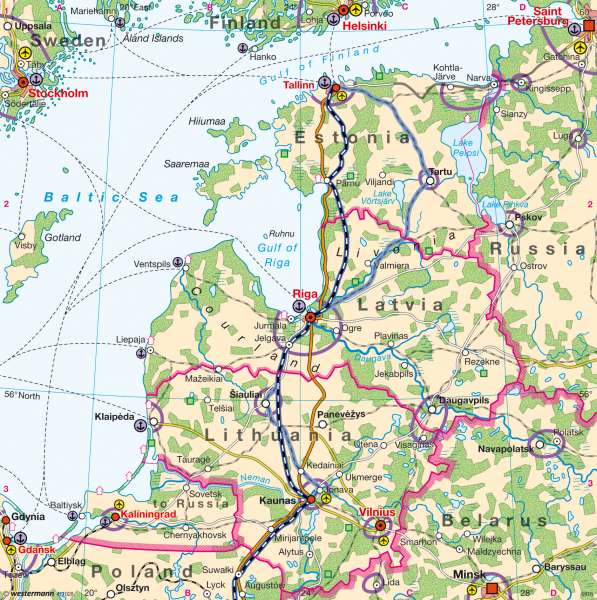EU — Infrastructure and development in the Baltic States
Europe - European regions
978-3-14-100790-9 | Page 40 | Ill. 1

Information
For long periods of their recent history, the three Baltic countries of Lithuania, Latvia and Estonia were not independent. Most recently they were incorporated into the Soviet Union during the Second World War — as the Lithuanian, Latvian and Estonian Soviet Socialist Republics. Lithuania was the first to rid itself of foreign dominance, declaring its sovereignty on 11 March 1990. Latvia and Estonia took the same step on 4 May 1990 and on 20 August 1991.Since 2004 the Baltic countries have been members of the European Union (EU), and since 2007 they have been part of the Schengen Area, within which there are no longer any internal border controls inside the EU. Many economic structures and parts of the infrastructure in Lithuania, Latvia and Estonia can be explained by the Soviet legacy. With their new political orientation, the countries face the challenges of renewal and structural change.
Regions and Transport Routes
The most striking relic of the Soviet era is the gauge of the railway system, which is 1,520 millimetres. Thus it is incompatible with the 1,435 millimetre standard gauge of the neighbouring EU countries. In Lithuania, for example, out of a railway network of some 1,800 kilometres, only a small section of less than 22 kilometres on the border with Poland is standard gauge. Moreover, only 122 kilometres of line in the country are electrified.
In Latvia the railway operates on the broad gauge for its entire length of 2,263 kilometres. In Estonia the railways have hitherto played a subordinate role; passenger transport is mainly by bus, and the only electrified sections of the 1,200 kilometre rail network are located in the region around the capital city of Tallinn.
A priority goal of restructuring is to connect the strongest, although troubled, economic regions with one another. In Lithuania these are the capital Vilnius, Kaunas in the centre, the port city of Klaip?da and northern centre of ?iauliai. In Latvia the region around the capital city of Riga is dominant; also of importance is Daugavpils which, together with Visaginas in Lithuania, is at the centre of a cross-border economic region. Estonia features three economic focal points: the capital Tallinn, Tartu in the centre, and the coastal locations of Kohtla-Järve and Narva.
Rail Baltica
The central modernization project within the Baltic countries is Rail Baltica, which should ideally be completed in 2015. By that date there will be a standard-gauge, through rail connection from Warsaw as far as Tallinn with a connection to Helsinki. In the other direction, this will bring improved connections to Berlin via Pozna?.
In the first stages, existing structures will be upgraded. For example, in Estonia the platforms will be lowered to the height that is normal throughout the EU, and the line between Tallinn and Tartu will be upgraded for speeds of 160 km/h by 2013. The entire project will be largely financed with funds from the EU.
D. Falk; Ü: J. Attfield




